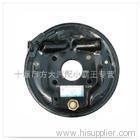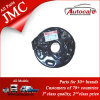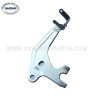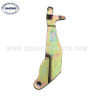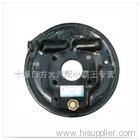In cars, the hand brake (also known as the emergency brake, e-brake, or parking brake) is a latching brake usually used to keep the car stationary. Automobile e-brakes usually consist of a cable (usually adjustable for length) directly connected to the brake mechanism on one end and to some type of lever that can be actuated by the driver on the other end. The lever is traditionally and more commonly a hand-operated system (hence the hand brake name), the most common configuration being a handle on the floor between the driver and front passenger, and less commonly being a handle bar located on the lower portion of the dashboard somewhere close to the steering wheel column or between the driver and their door. Alternatively, the lever can be on the floor between the driver and the door or foot-operated, in the form of a pedal in the foot well in front of the driver, located to the far left apart from the other pedals.
Although sometimes known as an emergency brake, using it in any emergency where the footbrake is still operational is likely to badly upset the brake balance of the car and vastly increase the likelihood of loss of control of the vehicle, for example by initiating a rear-wheel skid. Additionally, the stopping force provided by using the handbrake instead of or in addition to the footbrake is usually small and would not significantly aid in stopping the vehicle, again because it usually operates on the rear wheels; they suffer reduced traction compared to the front wheels while braking. The emergency brake is instead intended for use in case of mechanical failure where the regular footbrake is inoperable or compromised, hopefully with opportunity to apply the brake in a controlled manner to bring the vehicle to a safe, if gentle halt before seeking service assistance. Modern brake systems are typically very reliable and engineered with failsafe (e.g. dual-circuit hydraulics) and failure-warning (e.g. low brake fluid sensor) systems, meaning the handbrake is no longer often called on for its original purpose.
The most common use for an automobile emergency brake is to keep the vehicle motionless when it is parked, thus the alternative name, parking brake. Car emergency brakes have a ratchet locking mechanism that will keep them engaged until a release button is pressed. On vehicles with automatic transmissions, this is usually used in concert with a parking pawl in the transmission. Automotive safety experts recommend the use of both systems to immobilize a parked car, and the use of two systems is required by law in some jurisdictions, yet many individuals use only the "Park" position on the automatic transmission and not the parking brake. Also, manual transmission cars are recommended to be left in their lowest gear (usually either first or reverse) when parked, especially when parked on an incline.
